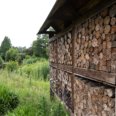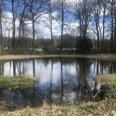As a university, we work hard to preserve our sustainable solutions. A reedbed filter serves to filter the water used to cool our buildings, as pollution by for example leaves leads to corrosion of the system
The 10 million liters of water stored in the Cool Circle are prone to contamination, due to weather and pollution from the environment. Contaminated water can lead to corrosion and blockages in the system. To combat this, a reedbed filter was built. A reedbed filter uses helophytes to purify polluted water. These reeds are plants that grow above water but have their roots in very wet soil and can transport oxygen to their roots by themselves.
Behind the Horst are two fields of gravel, sand and root cloth on which reed plants have been planted. The dirty water that flows in at the top of the filter is filtered through the gravel, where the roots of the reeds naturally extract dirt and other impurities. Around the roots of the plans live bacteria, which convert the contaminants into nutrients for the plants and for themselves. The water leaving the reedbed filter is clean enough to be used again in the system.





